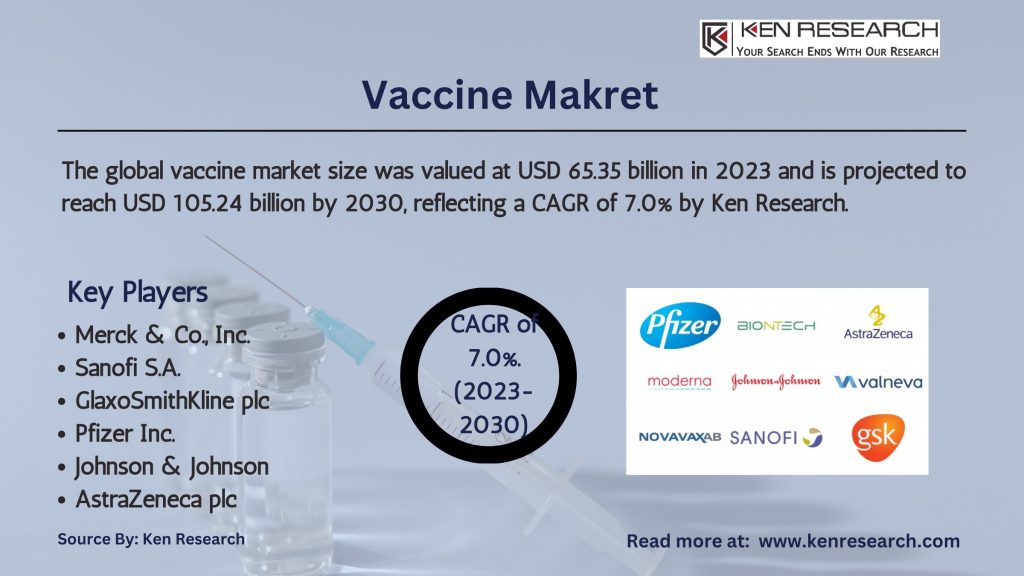Vaccines, one of humanity’s greatest public health achievements, have saved countless lives and continue to play a crucial role in preventing infectious diseases. The vaccine market, encompassing the development, production, and distribution of these life-saving products, is a vital sector within the healthcare industry. This blog delves into the current state of the vaccine market, analyzing its size, segmentation, key players, recent trends, and future outlook.
Market on the Rise: Size, Share, and Growth

The global vaccine market is experiencing steady growth. According to a report by Ken Research, the market size reached a significant $65.35 billion in 2023 and is projected to reach a colossal $105.24 billion by 2030, boasting a healthy CAGR (Compound Annual Growth Rate) of 7%. This growth is driven by several factors:
- Rising Focus on Immunization Programs: Governments worldwide are prioritizing childhood immunization programs and promoting vaccination campaigns for adults, expanding the market reach.
- Emerging Infectious Diseases: The emergence of new infectious diseases, coupled with the ongoing threat of vaccine-preventable illnesses, fuels demand for innovative vaccines.
- Technological Advancements: The development of novel vaccine platforms like DNA vaccines and recombinant vaccines offers opportunities for more effective and faster vaccine development.
Market Segmentation: A Spectrum of Vaccines
The vaccine market is segmented based on various factors, reflecting the diverse range of diseases vaccines target:
- By Vaccine Type:
- Live Attenuated Vaccines: These vaccines use weakened forms of the virus to stimulate the immune system to develop immunity. Examples include measles, mumps, and rubella (MMR) vaccines.
- Inactivated Vaccines: These vaccines utilize killed viruses that cannot replicate but still trigger an immune response. Examples include influenza and polio vaccines.
- Recombinant Vaccines: Engineered using genetic engineering techniques, these vaccines offer advantages like high purity and faster production timelines. Hepatitis B and shingles vaccines are examples.
- DNA Vaccines: A relatively new technology, these vaccines use DNA to instruct cells to produce specific antigens, potentially offering long-lasting immunity.
- By Disease:
- Pediatric Vaccines: This segment caters to the vital immunization of children against various diseases, including diphtheria, tetanus, pertussis (DTP), polio, and rotavirus. The pediatric vaccines market holds a significant share due to global immunization programs.
- Influenza Vaccines: The annual need for seasonal influenza vaccines contributes significantly to the market size.
- Shingles Vaccines: As the population ages, the demand for shingles vaccines is expected to rise.
-
- Dengue Vaccine Market: This segment is witnessing growth due to the rising prevalence of dengue fever in tropical and subtropical regions.
- Other Vaccines: The market also includes vaccines for diseases like malaria, meningitis, and tetanus, with ongoing research and development for emerging threats.
Take a look at: Exploring Trends in the $70.7 Billion Vaccine Market by 2027
Vaccine Industry Competitors and Market Share

The vaccine industry is a complex landscape with established players like Merck & Co., Pfizer, Sanofi, and GSK (GlaxoSmithKline) holding a significant market share. Additionally, emerging companies and research institutions are developing novel vaccines, fostering competition and innovation.
Market Trends: Shaping the Future of Vaccines
Several trends are shaping the future of the vaccine market:
- Focus on Global Health Equity: Ensuring equitable access to vaccines for low- and middle-income countries is a growing focus, driving initiatives to increase vaccine affordability and availability.
- Personalized Vaccines: The development of personalized vaccines tailored to individual immune responses holds promise for improved efficacy and potential treatment of chronic diseases.
- Advancements in Vaccine Delivery Systems: Novel delivery systems like microneedles and thermostable vaccines can improve vaccine administration, storage, and accessibility in resource-limited settings.
Opportunities and Challenges: Balancing Innovation and Access
The vaccine industry presents exciting opportunities:
- Emerging Markets: Growing healthcare expenditure and rising immunization rates in emerging markets offer significant growth potential.
- Focus on Multivalent Vaccines: Combining protection against multiple strains in a single vaccine can simplify immunization schedules and improve public health outcomes.
- Technological Advancements: Continued advancements in vaccine research and development hold the promise of more effective and targeted vaccines for a wider range of diseases.
However, the vaccine market also faces some challenges:
- Vaccine Hesitancy and Misinformation: Countering vaccine hesitancy and addressing misinformation campaigns remain crucial to ensure optimal vaccine uptake.
- High Development Costs: The significant financial investment required for vaccine development can be a barrier for smaller companies and limit innovation.
- Maintaining Cold Chain Logistics: Ensuring proper storage and transportation of temperature-sensitive vaccines, particularly in remote areas, remains a challenge.
Vaccine Market Forecast and Future Outlook: A Brighter Tomorrow
The vaccine market future outlook is promising. Continued focus on global immunization programs, technological advancements, and the development of new vaccines for emerging diseases will fuel market growth. By addressing challenges like vaccine hesitancy and ensuring equitable access, the vaccine industry can play a pivotal role in creating a healthier future for all.
Conclusion
The vaccine market is at a pivotal moment, with the potential to significantly impact public health and economic development globally. While challenges remain, the opportunities for growth, innovation, and collaboration are immense. As the industry continues to evolve, staying informed about market trends, segmentation, and the competitive landscape will be crucial for stakeholders aiming to contribute to the health and well-being of populations worldwide. By embracing new technologies, fostering partnerships, and prioritizing equity, the vaccine industry can continue to save lives and prevent disease for generations to come.
You can also read about: Can the Vaccine Market Sustain its Impressive Growth Rate of 7.5% CAGR?

